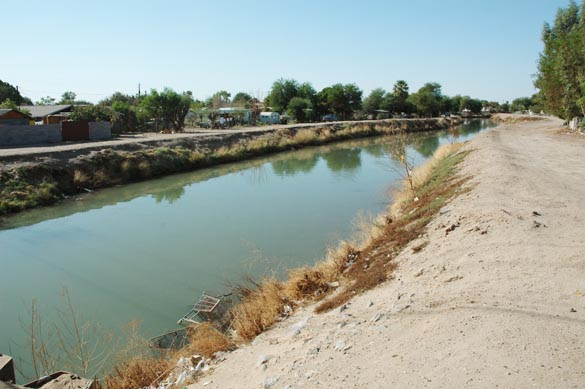|
• The story of Wellton-Mohawk • |
|
♦ Wellton-Mohawk ♦
Wellton-Mohawk is an irrigation project located on the Lower Gila river in southwestern Arizona, east of Yuma.
Over the years, the name has come to represent the problems of salt management in the irrigation of arid lands.
Yet, despite the bad publicity, Wellton-Mohawk is managing to do one thing correctly: It is draining its return flows directly to the ocean.
Many irrigation projects around the world, including those of the San Joaquin valley in California, do not come close to accomplishing this objective.
The story of how Wellton-Mohawk came to drain its return flows to the ocean is convoluted yet instructive.
The U.S. Bureau of Reclamation built the project in the late 1940s and early 1950s. In 1951,
the Wellton-Mohawk Irrigation and Drainage District
was created to oversee the irrigation of up to 75,000 acres in the Lower Gila valley, between the towns of Wellton and Mohawk.
The water, 278,000 acre-feet per year, comes from the Colorado river through the Gila Canal to the Wellton-Mohawk Canal,
and it is pumped to the headwaters a total of 160 feet, in three stages.
Initially, the Bureau underestimated the need for drainage and did not build the drainage infrastructure that was required for
irrigation in arid lands.
Within a few years, the lack of drainage led to rising water tables and increased salinity,
a situation which made it absolutely necessary to drain the lands. In desperation, farmers began to use the old wells
existing in the valley from the days prior to irrigation (Note that
the name "Wellton" comes from Well Town).
The farmers pumped the groundwater, lowered the water table,
and built a master drain to collect the pumped return flows (Fig. 1).

|
Fig. 1 Pumping at Wellton-Mohawk, from groundwater to drain.
In 1961, Wellton-Mohawk return flows began flowing to the Gila river, eventually to make their way to the Colorado. The increased salinity of the return flows caused a spike in salinity levels of the Colorado river, which were already high due to irrigation upstream. The salinity of Colorado river water at Imperial Dam increased from 693 ppm in 1945 to 894 in 1970. Acting on this issue, Mexico complained to the United States that the water being delivered to them was too salty. In 1973, the United States agreed to correct the situation, primarily through the treatment of Wellton-Mohawk return flows at a desalination plant to be built in Yuma. The original intent was to treat the return flows with reverse osmosis, return the clean water back to the Colorado river, and dispose of the brine through a drain into the Gulf of California.
♦ Drainage to coastal waters ♦
The plant, completed in 1992, never went into operation. The 1973 agreement also required a surface drain to carry brine from the desalination plant, including any untreated Wellton-Mohawk return flows, to coastal waters (Fig. 2). Mexico built the extension of this drain from the border to the coast. For fifteen years now, the return flow from Wellton-Mohawk, high in salts, has flowed into Santa Clara Slough, in Sonora. By all accounts, the slough has benefited from these flows. There are those who argue that the current situation is fine as is, and that flows to the slough should continue. This situation leaves the Yuma desalination plant idle.

|
Fig. 2 Main drain at San Luis, Arizona, near the Mexican border.
The current plan is to use the plant only when the flow on the Colorado river is sufficiently low to justify not bypassing Wellton-Mohawk return flows to the Santa Clara Slough. Presumably, this would be needed to comply with the 1973 agreement that the salinity of Colorado river water delivered to Mexico should not exceed 145 ppm greater than the value at Imperial Dam.
Currently, approximately 90 wells, at an average depth of 100 feet, are being operated by the Wellton-Mohawk district to keep the depth of the water table below root level. In fact, Wellton-Mohawk may be one of the few irrigation projects in the world to pump the surface water upstream and then to pump its own groundwater to drain the lands. Yet they are doing one thing right: They are delivering the return flows directly to the ocean, where they belong.

